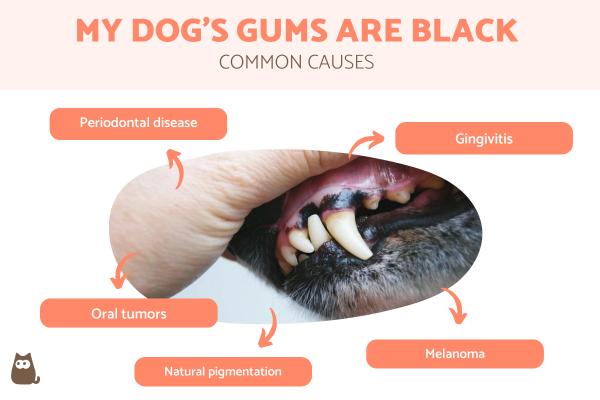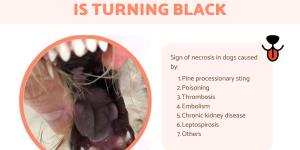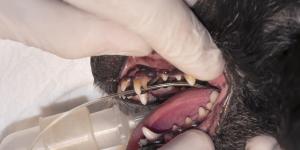My Dog's Gums Are Black



See files for Dogs
If your dog has black gums, it is important to know when this is normal and when it is a sign of a health problem. Poor dental hygiene is a common issue of the latter. Many oral diseases can worsen over time or, in some cases, lead to other pathologies. The moment we realize something is wrong with our dog's mouth, teeth or gums, it is vital we seek veterinary medical advice as soon as possible. It must be remembered that only a veterinary specialist can diagnose the problem. You may be referred to a veterinarian with dental expertise.
In this AnimalWised article on why my dog's gums are black, we look at the causes of this phenomenon as well as possible treatment options which may be available.
Are my dog's gums naturally black?
If we observe our dog's gums are black, the first thing we need to do is determine whether they have changed color or are naturally black. Some dogs have natural black pigment in the mucus membranes of their mouth and gums. The reason for this is genetic, the same reason why dogs have various colors of coat. It does not mean there is a problem. This coloration can extend over all the mouth or only be in black patches on dog gums.
Not many dog breeds have this feature, although some dogs are more likely to have it than others. Few have completely black mouths, tongues or gums, but there are some with naturally occurring black spots. Sometimes the coloration makes it look like the dog has a purple tongue instead of black, but various tones are possible, including blue.
Dog breeds with black or blue tongues may also naturally have entirely black gums or black spots in their mouth. These breeds include the following:
- Chow Chow
- Shar Pei
- Dalmatian
- Australian Shepherd
- Irish Setter
- Pit Bull breeds
- Mastiff breeds
- Newfoundland
The color and quality of our dog's gums are a signifier of the dog's overall health. If a dog's gums are unnaturally black, it can be the sign of various health issues. If the dog's gums are too pale, very red or anything other than their normal color, it can also be a sign of trouble. For example, bluish gums could signify cyanosis, a condition where insufficient oxygen is getting to the mucus membranes. Yellowish gums could be an indication of jaundice in dogs.
We need to know if any black coloration in our dog's mouth is natural or if the black spots are appearing unnaturally. One important way we can distinguish between the two is by looking at any concurrent symptoms. If your dog has black gums and bad breath (other than natural dog breath), it may be a sign of a medical problem. Loss of the dog's teeth, bleeding, inflammation and other signs might also help us to determine a cause.
Why are my dog's gums turning black?
As stated above, some dog breeds have naturally occurring black pigment in their gums, tongue or mouth. Whether you adopted your dog as a puppy or an adult, you should regularly check the health status of their mouth. It could be when feeding them a treat, when playing with a toy or simply seeing them yawn on the sofa. It is during these times you might first notice the dog's gums are turning black or black spots suddenly appear.
Reasons a dog's gums are black
Although you will need to take the dog to a veterinarian to carry out proper diagnostic tests, it is good to know what you might expect. It is also important to work out if the gums have indeed turned black or if it is simply a pigment issue. It is also possible the dog has eaten something which has temporarily stained their gums a different color, e.g. they have been chewing on a pen and the ink has run.
There are not many diseases which will cause a dog's gums to turn black, but the most common include:
- Periodontal disease: if the animal is not provided with proper and consistent oral care, they can suffer from periodontal disease, also known as gum disease. Over time, the gums can darken, especially when they are not well irrigated. Gum disease can also result in other types of discoloration or symptoms such as bad breath in dogs or bleeding.
- Gingivitis: while gingivitis is a type of periodontal disease which usually occurs in the early stages, it is worth mentioning it specifically. This is because gingivitis can present as a black line on the gum around the teeth. Inflammation is also likely, so you should look for textural changes as well as color changes to the dog's mouth.
- Acanthosis nigricans: acanthosis is a skin disease that is well known in humans, but little-described in dogs. It is characterized by providing discoloration in specific areas of the body. The gums are also affected and in many cases they also tend to darken.
- Periodontal tumors: any abnormal growth in the area of the periodontium will compromise irrigation and hypoxia will lead to darkening of the gums. Tumors may be benign or malign, but it is up to a veterinarian to determine the underlying cause.
- Melanoma: again, although this is a type of oral tumor, it is worth singling our since it is the most common type of oral malignancy in dogs[1]. Early detecting is imperative so that treatment can prevent this disease from spreading.
It should be taken into account that the change of color in the gums can be seen as a long-term consequence of any of these conditions. It is relatively rare for a dog to have their gums change color to black. It is unlikely it will happen all of a sudden either, but we need to check their mouth regularly. Regular brushing should be carried out anyway, so this gives us a good opportunity to examine their oral health.
Other dog gum colors
We have explained the reasons why a dog's gums are black, but there are other discolorations of a dog's gums that can occur. While we will need to have them diagnosed by a veterinarian, we can look at the different discolorations of dog gums to see what they might mean for the health of the animal:
- Black gums: as we have already explained, this could be due to the diseases mentioned above if they are not part of their natural coloration.
- Pale white gums: pale mucous membranes are a symptom that often accompany very serious problems such as heart disease, severe dehydration or even going into toxic shock. In all these cases, it is likely that the pale mucous membranes are accompanied by other symptoms such as lethargy or even losing consciousness.
- Yellow gums: this is a sign of jaundice in dogs. Jaundice occurs due to a build up of bile, meaning there is a problem in the liver. There are various types of liver problems in dogs which can lead to yellow gums and skin.
- Blue gums: as we have mentioned above, some dogs such as the Chow Chow might have naturally blue or purplish gums. When this is not the case, blue gums can signify cyanosis, meaning the dog is not getting enough oxygen. This is most often due to heart problems or issues with their blood circulation.
- Red gums: while most healthy dogs will have healthy pink gums, if they turn a bright red, there is likely a problem This could be an oral disease such as gingivitis, but it can also be a sign of very serious illnesses such as congestive heart failure, sepsis or heat stroke in dogs.
As we have already stated, it is important you look to any other possible symptoms which might be concurrent to the dog's gum discoloration. Relay this information to your veterinarian to aid in the diagnosis.

What to do if my dog has black gums
Since it is possible the black discoloration of your dog's gums is due to an underlying pathology, it is vital we take them to a veterinarian for diagnosis. It is imperative we do not try to medicate the dog ourselves. You may completely misdiagnose the dog and not treat the actual problem at all. There are also many human medications which are toxic or otherwise unsuitable for dogs. Self-administering treatment for black gums in dogs is dangerous and seriously threatens their help.
The prognosis of treatment will depend on the progress of the underlying cause. For example, a dog with benign tumors in the mouth may respond well to surgery, but a malignant melanoma may be more difficult to treat. Periodontal disease can be difficult to retard, but improving their dental hygiene routine can be of great help. Listen to your veterinarian's advice and act accordingly.

This article is purely informative. AnimalWised does not have the authority to prescribe any veterinary treatment or create a diagnosis. We invite you to take your pet to the veterinarian if they are suffering from any condition or pain.
If you want to read similar articles to My Dog's Gums Are Black, we recommend you visit our Other health problems category.
1. Bergman, P. J. (2007). Canine Oral Melanoma. Clin Tech Small Anim Pract, 22(2), 55-60.
https://www.ncbi.nlm.nih.gov/pubmed/17591290
- Carlson and Giffin. (2002). Practical canine veterinary manual. Madrid. Editorial el Drac.






